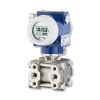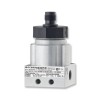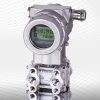Differential pressure sensors can double as gauge pressure sensors. Here we will explain how a DP sensor is used to measure gauge pressure.
- Gauge pressure measures pressure relative to the atmosphere.
- Differential pressure sensors measure the difference between two pressures.
- A differential pressure sensor can be used as a gauge pressure sensor by leaving one side open to the atmosphere.
Featured differential pressure sensor products
 250″wc Orifice plate flow measurement dp transmitter - This differential pressure (dp) transmitter can be used to measure the difference in upstream and downstream flowing pressure either side of a orifice plate.
250″wc Orifice plate flow measurement dp transmitter - This differential pressure (dp) transmitter can be used to measure the difference in upstream and downstream flowing pressure either side of a orifice plate. Air DP Sensors - Air differential pressure sensors play a vital role in maintaining environmental control and safety within critical applications such as cleanrooms, laminar flow cabinets, and ventilation systems.
Air DP Sensors - Air differential pressure sensors play a vital role in maintaining environmental control and safety within critical applications such as cleanrooms, laminar flow cabinets, and ventilation systems.
Gauge pressure is the measurement of pressure relative to the surrounding atmospheric pressure. This is normally achieved by using a sensor which has the reverse side of the sensing diaphragm open to atmosphere via a reference tube or port.
A differential pressure sensor is designed for pressure to be applied to both sides, so the mechanical design and fittings are similar on both sides of the diaphragm.
Even though the reverse side connection of a dp sensor is designed to withstand a range of pressures, and protected against liquids in many cases, it is perfectly okay, despite its underuse, to leave the process connection open and vented to atmosphere.
When pressure is now applied to the forward side connection of the dp sensor, it will be measured relative to atmospheric pressure, operating in exactly the same way as a gauge reference pressure sensor.
Featured differential pressure sensor products
 Rangeable DP Sensors - Rangeable differential pressure (DP) sensors provide a high degree of flexibility in measurement applications by allowing users to adjust the output signal.
Rangeable DP Sensors - Rangeable differential pressure (DP) sensors provide a high degree of flexibility in measurement applications by allowing users to adjust the output signal. 20 pascal differential pressure transducer for clean rooms - Voltage output pressure transducer with 0-20 Pa range for cleanroom applications. Provides reliable pressure monitoring to prevent contamination in critical environments.
20 pascal differential pressure transducer for clean rooms - Voltage output pressure transducer with 0-20 Pa range for cleanroom applications. Provides reliable pressure monitoring to prevent contamination in critical environments.
Here are the steps involved in measuring gauge pressure using a differential pressure sensor:
- Make sure that the reverse or negative side of the sensor is left open to the atmosphere.
- Connect the forward or positive side of the differential pressure sensor to the system to be measured.
- The pressure that you apply will be measured relative to atmospheric pressure.
- The sensor will output a value that corresponds to the gauge pressure.
Related Help Guides
- Measuring vacuum with negative gauge or absolute ranges
- What is the difference between gauge and absolute pressure measurement
- Measuring negative pressure using a positive differential pressure range
- Measuring liquid level in a sealed tank with a hydrostatic pressure sensor
- Measuring the difference in air pressure between rooms
- What does negative and positive gauge pressure mean
- Measuring vacuum as a negative gauge pressure using a dp sensor
- Measuring liquid level in a tank using a dp sensor
- Measuring density of a liquid using a dp sensor
Related Technical Terms
- Dry/Dry
- Gauge Reference Pressure
- Negative Gauge Pressure
- Reference Pressure
- SG – Sealed Gauge
- Static Line Pressure
- Vented Cable
- Vented Gauge
- Wet/Dry
- Wet/Wet
Related Online Tools
- DP Flow Transmitter Output Calculator
- High and Low Side Pressure to Differential Pressure Calculator
- Gauge + Barometric to Absolute Pressure Calculator
Related Product and Application Guides
Related Application Questions and Answers
- 2m range 0.6% conc. chlorine liquid level sensor
- 16 bar, 200°C steam pressure transmitter and gauge
- All-In-One transmitter for measuring steam temperature to 150°C and pressure to 4kg/cm² g
- USB pressure sensors for detecting water leaks & restrictions
- Leak testing set for checking 1mb/min drop at negative 10 mbar vacuum
- Resource testing logger for water wells with flow rate monitor & pressure transducer
- Vacuum suction sensor & wall mount digital readout with switched contacts
- Stainless steel 316L wetted parts 100 mbar ATEX pressure transmitter
- Industrial dishwasher 0-1m 0-10Vdc water level sensor
- Solvent compatible +/-100mWG dp transmitter with PTFE seals
- Logger for verifying water supply pressure over 7 days
- Vacuum pump inlet to outlet differential pressure sensor with 1500 Torr range
Contact us about this Measuring gauge pressure using a dp sensor page to request more information, or to discuss your application requirements.

